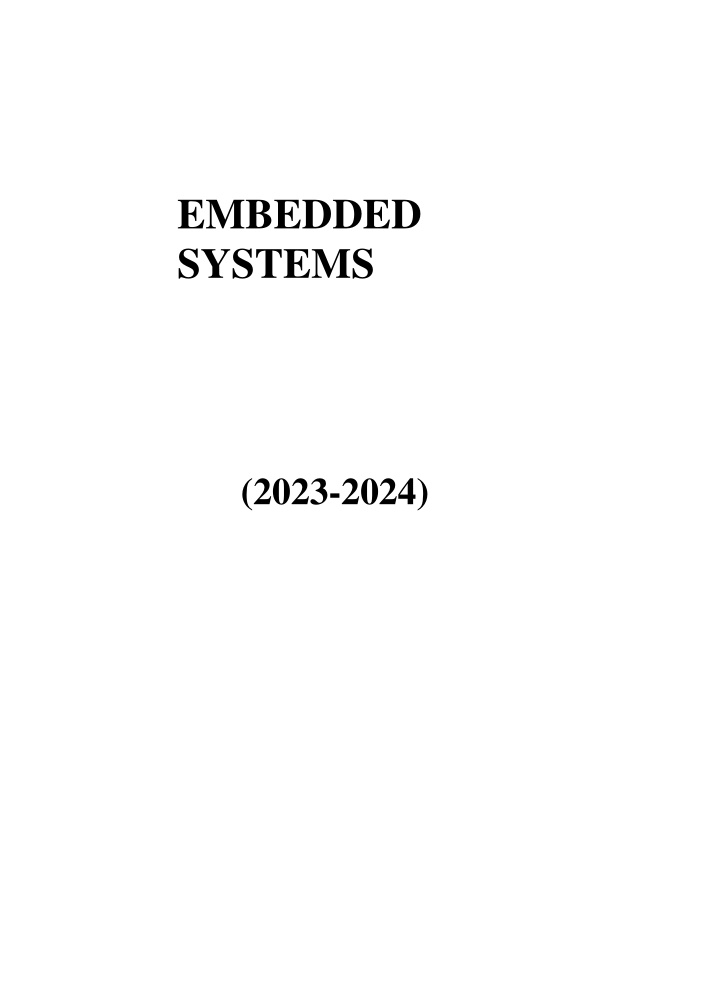
Overview of Embedded Systems Course 2023-2024
Explore the course objectives, unit topics, communication interfaces, embedded firmware design, RTOS concepts, recommended textbooks, and course outcomes for the Embedded Systems course in 2023-2024. Learn about the basics of embedded systems, components, communication interfaces, firmware design, operating systems, and more. Dive into the world of embedded systems with this comprehensive course.
Download Presentation

Please find below an Image/Link to download the presentation.
The content on the website is provided AS IS for your information and personal use only. It may not be sold, licensed, or shared on other websites without obtaining consent from the author. If you encounter any issues during the download, it is possible that the publisher has removed the file from their server.
You are allowed to download the files provided on this website for personal or commercial use, subject to the condition that they are used lawfully. All files are the property of their respective owners.
The content on the website is provided AS IS for your information and personal use only. It may not be sold, licensed, or shared on other websites without obtaining consent from the author.
E N D
Presentation Transcript
EMBEDDED SYSTEMS (2023-2024)
COURSE OBJECTIVES: For embedded systems, the course will enable the students to: 1.Understand the basics of an embedded system. 2.Understand the typical components of an embedded system. 3.To understand different communication interfaces. 4.To learn the design process of embedded system applications. 5.To understands the RTOS and inter-process communication. UNIT-I INTRODUCTION TO EMBEDDED SYSTEMS History of embedded systems, Classification of embedded systems based on generation and complexity, Purpose of embedded systems, The embedded system design process-requirements, specification, architecture design, designing hardware and software, components, system integration, Applications of embedded systems, and characteristics of embedded systems. UNIT-II TYPICAL EMBEDDED SYSTEM Core of the embedded system-general purpose and domain specific processors, ASICs, PLDs, COTs; Memory-ROM, RAM, memory according to the type of interface, memory shadowing, memory selection for embedded systems, Sensors, actuators, I/O components: seven segment LED, relay, piezo buzzer, push button switch, other sub- systems: reset circuit, brownout protection circuit, oscillator circuit real time clock, watch dog timer.
UNIT-III COMMUNICATION INTERFACE On board communication interfaces-I2C, SPI, CAN, parallel interface; External communication interfaces-RS232 and RS485, USB, infrared, Bluetooth, Wi- Fi, ZigBee, GPRS, GSM. UNIT-IV EMBEDDED FIRMWARE DESIGN AND DEVELOPMENT Embedded firmware design approaches-super loop based approach, operating system based approach; embedded firmware development languages-assembly language based development, high level language based development. UNIT-V RTOS BASED EMBEDDED SYSTEM DESIGN Operating system basics, types of operating systems, tasks, process and threads, multiprocessing and multitasking, task scheduling: non-pre-emptive and pre-emptive scheduling; task communication-shared memory, message passing, Remote Procedure Call and Sockets, Task Synchronization: Task Communication/ Synchronization Issues, Task Synchronization Techniques TEXT BOOKS: 1.Introduction to Embedded Systems - shibu k v, Mc Graw Hill Education. 2.Computers as Components Wayne Wolf, Morgan Kaufmann (second edition). REFERENCE BOOKS: 1.Embedded System Design -frank vahid, tony grivargis, john Wiley. 2.Embedded Systems- An integrated approach - Lyla b das, Pearson education 2012. 3.Embedded Systems Raj Kamal, TMH COURSE OUTCOMES: Upon completion of this course, the students will be able to: 1.Understand the design process of an embedded system 2.Understand typical embedded System & its components 3.Understand embedded firmware design approaches 4.Learn the basics of OS and RTOS
EMBEDDED SYSTEM INTRODUCTION TO EMBEDDED SYSTEMS
1. Introduction to Embedded Systems What is Embedded System? An Electronic/Electro mechanical system which is designed to perform a specific function and is a combination of both hardware and firmware (Software) E.g. Electronic Toys, Mobile Handsets, Washing Machines, Air Conditioners, Automotive Control Units, Set Top Box, DVD Player etc Embedded Systems are: Unique in character and behavior With specialized hardware and software Embedded Systems Vs General Computing Systems: Purpose Computing System Embedded ) System General Asystem which is a combination of generic hardware and General Purpose Operating System for executing a variety of applications Asystem which is a combination of special purpose hardware and embedded OS for executing a specific set of applications Contain a General Purpose Operating System (GPOS) Applications are alterable (programmable) by The firmware of the embedded system is user (It is possible for the end user to re-installthe pre-programmed and it is non-alterable by Operating System, and add or remove user end-user applications) Performance is the key deciding factor on the Application specific requirements (like selection of the system. Always Faster is Better performance, power requirements, memory May or may not contain an operating system for functioning usage etc) are the key deciding factors Highly tailored to take advantage of the power saving modes supported by hardware and Operating System For certain category of embedded systems like mission critical systems, the response time requirement is highly critical Less/not at all tailored towards reduced operating power requirements, options for different levels of power management. Response requirements are not time critical Execution behavior is deterministic for Need not be deterministic in execution behavior certain type of embedded systems like Hard Real Time systems
History of Embedded Systems: First Recognized Modern Embedded System: ApolloGuidanceComputer(AGC)developedby Charles Stark Draperat the MIT Instrumentation Laboratory. It has two modules 1.Command module(CM) 2.Lunar Excursion module(LEM) RAM size 256 , 1K ,2K words ROM size 4K,10K,36K words Clock frequency is 1.024MHz 5000 ,3-input RTL NOR gates are used User interface is DSKY(display/Keyboard) First Mass Produced Embedded System: Autonetics D-17 Guidance computer for Minuteman-I missile Classification of Embedded Systems: Based on Generation (March-2017) Based on Complexity & Performance Requirements Based on deterministic behavior Based on Triggering 1. Embedded Systems - Classification based on Generation First Generation: The early embedded systems built around 8-bit microprocessors like 8085 and Z80 and 4-bit microcontrollers EX. stepper motor control units, Digital Telephone Keypads etc. Second Generation: Embedded Systems built around 16-bit microprocessors and 8 or 16-bit microcontrollers, following the first generation embedded systems EX.SCADA, Data Acquisition Systems etc. Third Generation: Embedded Systems built around high performance 16/32 bit Microprocessors/controllers, Application Specific Instruction set processors like Digital Signal Processors (DSPs), and Application Specific Integrated Circuits (ASICs).The instruction set is complex and powerful. EX. Robotics, industrial process control, networking etc.
Fourth Generation: Embedded Systems built around System on Chips (SoCs), Re- configurable processors and multicore processors. It brings high performance, tight integration and miniaturization into the embedded device market EX Smart phone devices, MIDs etc. 2. Embedded Systems - Classification based on Complexity & Performance Small Scale: The embedded systems built around low performance and low cost 8 or 16 bit microprocessors/ microcontrollers. It is suitable for simple applications and where performance is not time critical. It may or may not contain OS. Medium Scale: Embedded Systems built around medium performance, low cost 16 or 32 bit microprocessors / microcontrollers or DSPs. These are slightly complex in hardware and firmware. It may contain GPOS/RTOS. Large Scale/Complex: Embedded Systems built around high performance 32 or 64 bit RISC processors/controllers, RSoC or multi-core processors and PLD. It requires complex hardware and software. These processors/controllers and co-units/hardware accelerators for offloading the processing requirements from the main processor. It contains RTOS for scheduling, prioritization and management. system may contain multiple 3. Embedded Systems - Classification Based on deterministic behavior: It is applicable for Real Time systems. The application/task execution behavior for an embedded system can be either deterministic or non-deterministic These are classified in to two types 1. Soft Real time Systems: Missing a deadline may not be critical and can be tolerated to a certain degree 2. Hard Real time systems: Missing a program/task execution time deadline can have catastrophic consequences (financial, human loss of life, etc.) 4. Embedded Systems - Classification Based on Triggering: These are classified into two types 1. Event Triggered : Activities within the system (e.g., task run-times) are dynamic and depend upon occurrence of different events . 2. Time triggered: Activities within the system follow a statically computed schedule (i.e., they are allocated time slots during which they can take place) and thus by nature are predictable.
Major Application Areas of Embedded Systems: Consumer Electronics: Camcorders, Cameras etc. Household Appliances: Television, DVD players, washing machine, Fridge, Microwave Oven etc. Home Automation and Security Systems: Air conditioners, sprinklers, Intruder detection alarms, Closed Circuit Television Cameras, Fire alarms etc. Automotive Industry: Anti-lock breaking systems (ABS), Engine Control, Ignition Systems, Automatic Navigation Systems etc. Telecom: Cellular Telephones, Telephone switches, Handset Multimedia Applications etc. Computer Peripherals: Printers, Scanners, Fax machines etc. Computer Networking Systems: Network Routers, Switches, Hubs, Firewalls etc. Health Care: Different Kinds of Scanners, EEG, ECG Machines etc. Measurement & Instrumentation: Digital multi meters, Digital CROs, Logic Analyzers PLC systems etc. Banking & Retail: Automatic Teller Machines (ATM) and Currency counters, Point of Sales (POS) Card Readers: Barcode, Smart Card Readers, Hand held Devices etc. Purpose ofEmbedded Systems: Each Embedded Systems is designed to serve the purpose of any one or a combination of the following tasks. o Data Collection/Storage/Representation o Data Communication o Data (Signal) Processing o Monitoring o Control o Application Specific User Interface
1. Data Collection/Storage/Representation:- Performs acquisition of data from the external world. The collected data can be either analog or digital Data collection is usually done for storage, analysis, manipulation and transmission The collected data may be stored directly in the system or may be transmitted to some other systems or it may be processed by the system or it may be deleted instantly after giving a meaningful representation 2. Data Communication:- Embedded Data communication systems are deployed in applications ranging from complex satellite communication systems to simple home networking systems Embedded Data communication systems are dedicated for data communication The data communication can happen through a wired interface (like Ethernet, RS-232C/USB/IEEE1394 etc) or wireless interface (like Wi-Fi, GSM,/GPRS, Bluetooth, ZigBee etc) Network hubs, Routers, switches, Modems etc are typical examples for dedicated data transmission embedded systems 3. Data (Signal) Processing:- Embedded systems with Signal processing functionalities are employed in applications demanding signal processing like Speech coding, synthesis, audio video codec, transmission applications etc Computational intensive systems Employs Digital Signal Processors (DSPs)
4. Monitoring:- Embedded category monitoring purpose systems are coming under designed this for specifically They are used for determining the state of some variables using input sensors They cannot impose control over variables. Electro Cardiogram (ECG) machine for monitoring the heart beat of a patient is a typical example for this The sensors used in ECG are the different Electrodes connected to the patient s body Measuring instruments like Digital CRO, Digital Multi meter, Logic Analyzer etc used in Control & Instrumentation applications are also examples of embedded systems for monitoring purpose 5. Control:- Embedded systems with control functionalities are used for imposing control over some variables according to the changes in input variables Embedded functionality contains both sensors and actuators system with control Sensors are connected to the input port for capturing the changes in environmental variable or measuring variable The actuators connected to the output port are controlled according to the changes in input variable to put an impact on the controlling variable to bring the controlled variable to the specified range Air conditioner for controlling room temperature is a typical example for embedded system with Control functionality Air conditioner contains a room temperature sensing element (sensor) which may be a thermistor and a handheld unit for setting up (feeding) the desired temperature The air compressor unit acts as the actuator. The compressor is controlled according to the current room temperature and the desired temperature set by the end user.
6. Application Specific User Interface:- Embedded systems which are designed for a specific application Contains Application Specific User interface (rather than general standard UI ) like key board, Display units etc Aimed at a specific target group of users Mobile handsets, Control units in industrial applications etc are examples EMBEDDED SYSTEM DESIGN PROCESS: This section provides an overview of the embedded system design process aimed at two objectives. First, it will give us an introduction to the various steps in embedded system design before we delve into them in more detail. Second, it will allow us to consider the design methodology itself. A design methodology is important for three reasons. First, it allows us to keep a scorecard on a design to ensure that we have done everything we need to do, such as optimizing performance or performing functional tests. Second, it allows us to develop computer-aided design tools. Developing a single program that takes in a concept for an embedded system and emits a completed design would be a daunting task, but by first breaking the process into manageable steps, we can work on automating (or at least semi automating) the steps one at a time. Third, a design methodology makes it much easier for members of a design team to communicate. The below Figure summarizes the major steps in the embedded system design process. In this top down view, we start with the systemrequirements. Fig: Major levels of abstraction in the design process Requirements: Clearly, before we design a system, we must know what we are designing. The initial stages of the design process capture this information for use in creating the architecture and components. We generally proceed in two phases: First, we gather an informal description from the customers known as requirements, and we refine the requirements into a specification that contains enough information to begin designing the system architecture.
Requirements may be functional or nonfunctional. We must of course capture the basic functions of the embedded system, but functional description is often not sufficient. Typical nonfunctional requirements include: Performance: The speed of the system is often a major consideration both for the usability of the system and for its ultimate cost. As we have noted, performance may be a combination of soft performance metrics such as approximate time to perform a user-level function and hard deadlines by which a particular operation must be completed. Cost: The target cost or purchase price for the system is almost always a consideration. Cost typically has two major components: manufacturing cost includes the cost of components and assembly; nonrecurring engineering (NRE) costs include the personnel and other costs of designing the system. Physical size and weight: The physical aspects of the final system can vary greatly depending upon the application. An industrial control system for an assembly line may be designed to fit into a standard-size rack with no strict limitations on weight. A handheld device typically has tight requirements on both size and weight that can ripple through the entire system design. Power consumption: Power, of course, is important in battery-powered systems and is often important in other applications as well. Power can be specified in the requirements stage in terms of battery life the customer is unlikely to be able to describe the allowable wattage. A sample requirements form that can be filled out at the start of the project. We can use the form as a checklist in considering the basic characteristics of the system. Let s consider the entries in the form: Name: This is simple but helpful. Giving a name to the project not only simplifies talking about it to other people but can also crystallize the purpose of the machine. Purpose: This should be a brief one- or two-line description of what the system is supposed to do. If you can t describe the essence of your system in one or two lines, chances are that you don t understand it well enough. Inputs and outputs: These two entries are more complex than they seem. The inputs and outputs to the system encompass a wealth of detail: Types of data: Analog electronic signals? Digital data? Mechanical inputs? Data characteristics: Periodically arriving data, such as digitalaudio samples? Occasional user inputs? How many bits per data element? Types of I/O devices: Buttons?Analog/digital converters? Video displays? Functions: This is a more detailed description of what the system does. A good way to approach this is to work from the inputs to the outputs: When the system receives an input, what does it do? How do user interface inputs affect these functions? How do different functions interact? Performance: Many embedded computing systems spend at least some time controlling physical devices or processing data coming from the physical world. In most of these cases, the computations must be performed within a certain time frame. It is essential that the performance requirements be identified early since they must be carefully measured during implementation to ensure that the system works properly. Manufacturing cost: This includes primarily the cost of the hardware components. Even if you don t know exactly how much you can afford to spend on system components, you should have some idea of the eventual cost range. Cost has a substantial influence on architecture: A machine that is meant to sell at $10 most likely has a very different internal structure than a $100 system. Power: Similarly, you may have only a rough idea of how much power the system can consume, but a little information can go a long way. Typically, the most important decision is
whether the machine will be battery powered or plugged into the wall. Battery-powered machines must be much more careful about how they spend energy. Physical size and weight: You should give some indication of the physical size of the system to help guide certain architectural decisions. A desktop machine has much more flexibility in the components used than, for example, a lapel mounted voice recorder. GPS MODULE: REQUIREMENTS FORM OF GPS MOVING MAPMODULE: Name Name : : GPS GPS moving moving map map Purpose Purpose: : Consumer Consumer- -grade grade moving moving map map for for driving Inputs Inputs : : Power Power button, button, two two control control buttons buttons Outputs Outputs : : Back Back- -lit lit LCD LCD display display 400 400 _ _ 600 600 Functions Functions : : Uses Uses 5 5- -receiver receiver GPS GPS system system; ; three always always displays displays current current latitude latitude and and longitude longitude Performance Performance: : Updates Updates screen screen within within 0 0. .25 25 seconds Manufacturing Manufacturing cost cost: :$ $30 30 Power Power: : 100 100mW mW Physical Physical size size and and weight weight: : No No more more than driving use use three user user- -selectable selectable resolutions resolutions; ; seconds upon upon movement movement than 2 2 _ _ 6 6, , 12 12 ounces ounces Specification The specification is more precise it serves as the contract between the customer and the architects. As such, the specification must be carefully written so that it accurately reflects the customer s requirements and does so in a way that can be clearly followed during design. The specification should be understandable enough so that someone can verify that it meets system requirements and overall expectations of the customer. Aspecification of the GPS system would include several components: Data received from the GPS satellite constellation. Map data. User interface. Operations that must be performed to satisfy customer requests. Background actions required to keep the system running, such as operating theGPS receiver.
Architecture Design The specification does not say how the system does things, only what the system does. Describing how the system implements those functions is the purpose of the architecture. The architecture is a plan for the overall structure of the system that will be used later to design the components that make up the architecture. The creation of the architecture is the first phase of what many designers think of as design. This block diagram is still quite abstract we have not yet specified which operations will be performed by software running on a CPU, what will be done by special-purpose hardware, and so on. The diagram does, however, go a long way toward describing how to implement the functions described in the specification. We clearly see, for example, that we need to search the topographic database and to render (i.e., draw) the results for the display. We have chosen to separate those functions so that we can potentially do them in parallel performing rendering separately from searching the database may help us update the screen morefluidly. FIG: BLOCK DIAGRAM FOR THE MOVING MAP The hardware block diagram clearly shows that we have one central CPU surrounded by memory and I/O devices. In particular, we have chosen to use two memories: a frame buffer for the pixels to be displayed and a separate program/data memory for general use by the CPU. The software block diagram fairly closely follows the system block diagram, but we have added a timer to control when we read the buttons on the user interface and render data onto the screen. To have a truly complete architectural description, we require more detail, such as where units in the software block diagram will be executed in the hardware block diagram and when operations will be performed in time.
Fig : Hardware and software architectures for the moving map. The architectural description tells us what components we need. The component design effort builds those components in conformance to the architecture and specification. The components will in general include both hardware FPGAs, boards, and so on and software modules. Some of the components will be ready-made. The CPU, for example, will be a standard component in almost all cases, as will memory chips and many other components .In the moving map, the GPS receiver is a good example of a specialized component that will nonetheless be a predesigned, standard component. We can also make use of standard software modules. System Integration: Only after the components are built do we have the satisfaction of putting them together and seeing a working system. Of course, this phase usually consists of a lot more than just plugging everything together and standing back. Bugs are typically found during system integration, and good planning can help us find the bugs quickly. By building up the system in phases and running properly chosen tests, we can often find bugs more easily. If we debug only a few modules at a time, we are more likely to uncover the simple bugs and able to easily recognize them. Only by fixing the simple bugs early will we be able to uncover the more complex or obscure bugs that can be identified only by giving the system a hard workout
Characteristics of Embedded systems: Embedded systems possess certain specific characteristics and these are unique to each Embedded system. 1. Application and domain specific 2. Reactive and Real Time 3. Operates in harsh environments 4. Distributed 5. Small Size and weight 6. Power concerns 7. Single-functioned 8. Complex functionality 9. Tightly-constrained 10. Safety-critical 1. Application and Domain Specific:- Each E.S has certain functions to perform and they are developed in such a manner to do the intended functions only. They cannot be used for any other purpose. Ex The embedded control units of the microwave oven cannot be replaced with AC S embedded control unit because the embedded control units of microwave oven and AC are specifically designed to perform certain specific tasks.
T,VINAYSIMHA REDDY, Dept. of ECE, MRCET 2. Reactive and Real Time:- E.S are in constant interaction with the real world through sensors and user-defined input devices which are connected to the input port of the system. Any changes in the real world are captured by the sensors or input devices in real time and the control algorithm running inside the unit reacts in a designed manner to bring the controlled output variables to the desired level. E.S produce changes in output in response to the changes in the input, so they are referred as reactive systems. Real Time system operation means the timing behavior of the system should be deterministic ie the system should respond to requests in a known amount oftime. Example E.S which are mission critical like flight control systems, Antilock Brake Systems (ABS) etc are Real Time systems. 3. Operates in Harsh Environment : The design of E.S should take care of the operating conditions of the area where the system is going to implement. Ex If the system needs to be deployed in a high temperature zone, then all the components used in the system should be of high temperature grade. Also proper shock absorption techniques should be provided to systems which are going to be commissioned in places subject to high shock. 4. Distributed: It means that embedded systems may be a part of a larger system. Many numbers of such distributed embedded systems form a single large embedded control unit. Ex Automatic vending machine. It contains a card reader, a vending unit etc. Each of them are independent embedded units but they work together to perform the overall vending function. 5. Small Size and Weight:- Product aesthetics (size, weight, shape, style, etc) is an important factor in choosing a product. It is convenient to handle a compact device than a bulky product.
6. Power Concerns:- Power management is another important factor that needs to be considered in designing embedded systems. E.S should be designed in such a way as to minimize the heat dissipation by thesystem. 7. Single-functioned:- Dedicated to perform a single function 8. Complex functionality: - We have to run sophisticated algorithms or multiple algorithmsin some applications. 9. Tightly-constrained:- Low cost, low power, small, fast, etc 10. Safety-critical:- Must not endanger human life and the environment QualityAttributes of Embedded System: Quality attributes are the non-functional requirements that need to be documented properly in any system design.(DEC16,March-2017) Quality attributes can be classified as I. Operational quality attributes II. Non-operational quality attributes. I. Operational Quality Attributes: The operational quality attributes represent the relevant quality attributes related to the embedded system when it is in the operational mode or online mode. Operational QualityAttributes are: 1. Response :- It is the measure of quickness of the system. It tells how fast the system is tracking the changes in input variables. Most of the E.S demands fast response which should be almost real time. Ex Flight control application.
2. Throughput :- It deals with the efficiency of a system. It can be defined as the rate of production or operation of a defined process over a stated period of time. The rates can be expressed in terms of products, batches produced or any other meaningful measurements. Ex In case of card reader throughput means how many transactions the reader can perform in a minute or in an hour or in a day. Throughput is generally measured in terms of Benchmark . A Benchmark is a reference point by which something can be measured 3. Reliability :- It is a measure of how much we can rely upon the proper functioning of thesystem. Mean Time Between Failure (MTBF) and Mean Time To Repair (MTTR) are the terms used in determining system reliability. MTBF gives the frequency of failures in hours/weeks/months. MTTR specifies how long the system is allowed to be out of order followinga failure. For embedded system with critical application need, it should be of the order of minutes. 4. Maintainability:- It deals with support and maintenance to the end user or client in case of technical issues and product failure or on the basis of a routine system checkup. Reliability and maintainability are complementary to eachother. A more reliable system means a system with less corrective maintainability requirements and vice versa. Maintainability can be broadly classified into two categories 1. Scheduled or Periodic maintenance (Preventive maintenance) 2. Corrective maintenance to unexpected failures
5. Security:- Confidentiality, Integrity and availability are the three major measures of information security. Confidentiality deals with protection of data and application from unauthorized disclosure. Integrity deals with the protection of data and application from unauthorized modification. Availability deals with protection of data and application from unauthorizedusers. 6. Safety :- Safety deals with the possible damages that can happen to the operator, public and the environment due to the breakdown of an Embedded System. The breakdown of an embedded system may occur due to a hardware failure or a firmware failure. Safety analysis is a must in product engineering to evaluate the anticipated damages and determine the best course of action to bring down the consequences of damage to an acceptable level. II. Non-Operational Quality Attributes: The quality attributes that needs to be addressed for the product not on the basis of operational aspects are grouped under this category. 1. Testability and Debug-ability:- Testability deals with how easily one can test the design, application and by which means it can be done. For an E.S testability is applicable to both the embedded hardware and firmware. Embedded hardware testing ensures that the peripherals and total hardware functions in the desired manner, whereas firmware testing ensures that the firmware is functioning in the expected way. Debug-ability is a means of debugging the product from unexpected behavior in the system Debug-ability is two level process 1.Hardware level 2.software level 1. Hardware level: It is used for finding the issues created by hardware problems. 2. Software level: It is employed for finding the errors created by the flaws in thesoftware.
2. Evolvability :- It is a term which is closely related toBiology. It is referred as the non-heritable variation. For an embedded system evolvability refers to the ease with which the embedded product can be modified to take advantage of new firmware or hardware technologies. 3. Portability:- It is the measure of system independence. An embedded product is said to be portable if the product is capable of functioning in various environments, target processors and embedded operating systems. Porting represents the migration of embedded firmware written for one targetprocessor to a different target processor. 4. Time-to-Prototype and Market:- It is the time elapsed between the conceptualization of a product and the time at which the product is ready for selling. The commercial embedded product market is highly competitive and time to market the product is critical factor in the success of commercial embedded product. There may be multiple players in embedded industry who develop products of thesame category (like mobile phone). 5. Per Unit Cost and Revenue:- Cost is a factor which is closely monitored by both end user and product manufacturer. Cost is highly sensitive factor for commercial products Any failure to position the cost of a commercial product at a nominal rate may lead to the failure of the product in the market. Proper market study and cost benefit analysis should be carried out before taking a decision on the per-unit cost of the embedded product. The ultimate aim of the product is to generate marginal profit so the budget and total cost should be properly balanced to provide a marginal profit.






















